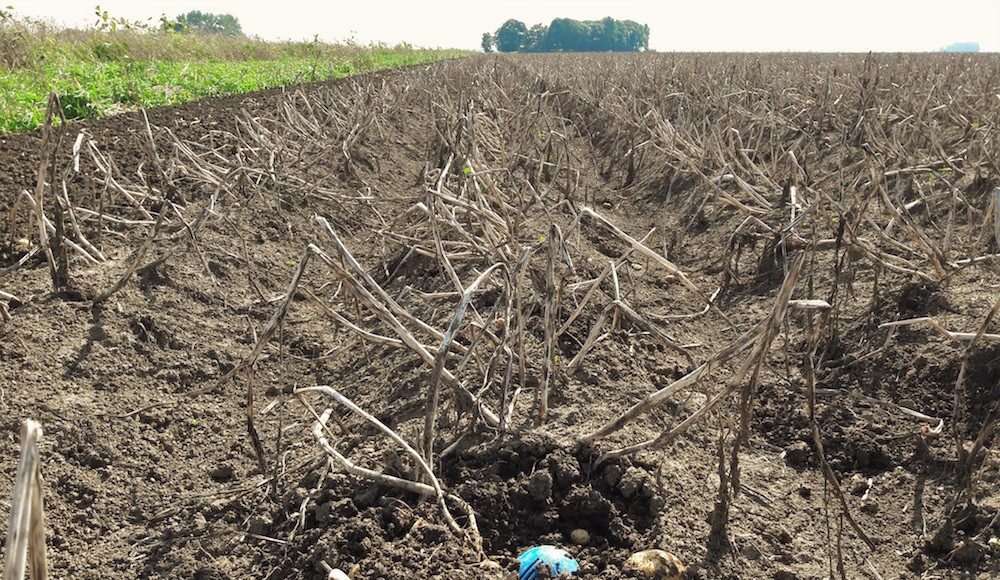[deck]Highlights of some new technologies designed to make potato production easier and more efficient.[/deck]
The Humigator
Designed by Idaho-based Isaacs Hydropermutation Technologies Inc., the Humigator is a combination of a humidifier and a fumigator. While its primary function is to clean the air in potato storage sites, which helps stop the spread and lower the risk of disease, it also humidifies to higher levels than older technologies, which reduces loss due to shrinkage. Garry Isaacs, the creator of the Humigator, designed the first prototype in 1985 and brought it to the potato industry in 2011.

So how does it work? The Humigator draws in air, taking with it airborne particulates, including spores and bacteria. According to CEO Blake Isaacs, the air is moved in the same direction as the ventilation system. The Humigator injects water into the air, creating a dense vapour. It uses patented dynamic multi-venturi technology to blow and scrub the storage air. The technology is especially good at removing crop-devastating airborne fungi spores such as silver scurf and black dot.
According to Isaacs, the Humigator can be used in all types of storages, even older buildings without ventilation. The base model, the 1230, is good for storage units that hold up to 2,000 tonnes. Model 1535 is suitable for units that hold 2,000-3,500 tonnes, and model 1835, the largest, is suitable for units that hold 3,500-5,000 tonnes. Anything over 5,000 tonnes requires multiple units. Prices range between US$12,000 for the base model to US$18,000 for the 1835.
“The Humigator costs just a little bit of water and electricity to run,” says Isaacs. “The other options for remediating those diseases are chemicals. For the organic growers, there really aren’t any good options other than humigation for remediation of some of the worst storage diseases.
“The advantage of our product is that it only uses water and electricity,” adds Isaacs. “Once you’ve installed it, it costs very little to operate, and you don’t have a recurring expense every year to prevent the spread of those diseases.”
Solgrader
Dutch company Solentum now offers a fast and easy way to calculate potato yield right in the field. Using the smartphone app, Solgrader, and a blue mat, growers simply take a photo of tubers on the mat and wait for results. A quick analysis of the image will tell growers tuber size, tuber weight and estimated yield per hectare.

“Last summer I did a lot of testing in the field with both companies and individual farmers, and without a doubt it makes your life easier as a grower,” said Sebastian Hamilton Jee, sales manager at Solentum. “With Solgrader you can put away the old calculator and manual grading tool.”
The app (with blue mat) costs EUR 79 (approximately CDN$110) for individuals and small farms. A yearly subscription fee of EUR 190 (approximately CDN$264) allows growers to access a report package and advice. Bigger companies pay license per number of users.
Due to logistical challenges, Solgrader is currently only available in Europe. However, Jee says that it will likely be ready for use in North America in a couple of years. “We have gotten much interest from American and Canadian customers,” he said. “It is my personal opinion that we will be there a lot faster than two years from now.”
SolAntenna
Have you ever been curious about what your potatoes experience from field to storage? Well, now you can know. SolAntenna, a multi-purpose electronic device in the shape of a potato, performs measurements all along the value chain. Planted alongside real potatoes in the field, SolAntenna takes measurements, helping growers to make decisions regarding fungicides applications and irrigation timing. SolAntenna is also created by Solentum.
During harvest, the device can be used to measure the level of physical shocks. Knowing exactly where the cause of damage occurs can help minimize the risk of disease later, since damaged potatoes are particularly vulnerable to fungal and bacterial infections.
SolAntenna can also be placed in boxes in storage and during transport. Here they measure temperature and CO2 levels. This information can be used to minimize yield loss.
Each SolAntenna device costs EUR 390 (approximately CDN$540); three devices are enough for a small farm. In 2017, Solentum plans to launch a cheaper version that measures shock only.
The idea for SolAntenna came out of a desire to solve disputes along the value chain, said Jee. Last year in particular there were a lot of complaints and a lot of claims to manage. “This was between breeders and growers, as well as growers and the processing industry,” said Jee. “Everybody was unhappy because it cost a lot of time and money to resolve these claims.
“When you have no data available, you can point your finger and blame someone, but you lack the evidence to prove that the potatoes were mishandled,” he notes.
Today, SolAntenna is being used to collect data all along the value chain to hopefully answer some of those questions.
Like Solgrader, SolAntenna is not yet available in Canada. Jee expects that it will be in the next couple of years though.











